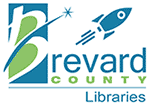Vetted Online Resources
Celebrating 50 Years of Brevard County Public Libraries!
Like many of the public libraries in the United States, most of the libraries in Brevard County were originally initiated by a club or an interested group of citizens banding together to organize and start a library program in their area or city. The first five public libraries in the county were all started in this fashion: Cocoa, Cocoa Beach, Eau Gallie, Melbourne, and North Brevard in Titusville.
In 1959, the Brevard County Board of County Commissioners and the cities started to implement Florida Statute 150, which gave county funding support to the five municipal libraries. In return the five libraries agreed to serve all county residents. The formula used for this support was a minimum of one-third from the cities and a maximum of two-thirds from the County to pay all operating expenses, and the city was required to furnish the building to house the library collection. This plan worked successfully for a number of years. During the sixties Brevard's population boomed as a result of the Aerospace Program and demands for library services began to come from many of the fast-growing areas of the county. Merritt Island and Satellite Beach were added to the county's libraries and then Cape Canaveral followed by Meadowlane in 1970. From 1960 to 1970, the number of libraries grew from five to nine.
The Brevard County Federated Library System was established in 1971 with the mission to give the best possible service to all county residents. It was at this time that Florida Statute 150 was rescinded and Brevard County Ordinance 72-1 became the legal authority for countywide library operations in Brevard. Under the Federated library system, the public libraries succeeded in expanding resources of each of the nine libraries to include the rich information sources of all. A borrower's card from any member library is accepted at all other libraries in the System, and the library materials borrowed from any single member library may be returned to any other member library. On November 7, 1972, Brevard citizens voted for a tax referendum that established a countywide Library Tax District that funds the total operating costs of the Brevard public libraries up to one mil.
With the establishment of the countywide Library Tax District, the nine libraries of the system contracted with the Board of County Commissioners for provision of countywide library services. In 1972, a County Library Board was established to "advise in the establishment, operation, and maintenance of a free public library service within the County." A County Library Services Director directed the administrative and professional services of the Brevard County Library system.
More than 50 Years of History!
Brevard County Libraries may only be a 50-year-old system, but many of our libraries have long and rich histories in their communities, and pre-date the creation of the system!
Cape Canaveral Public Library
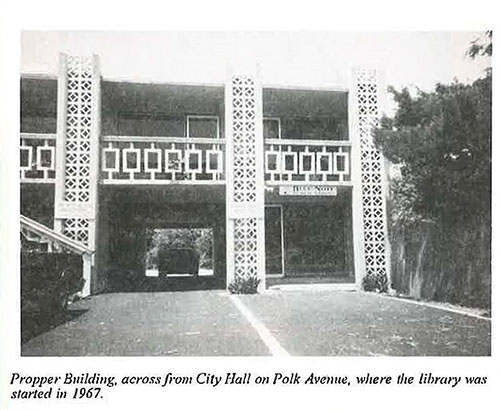
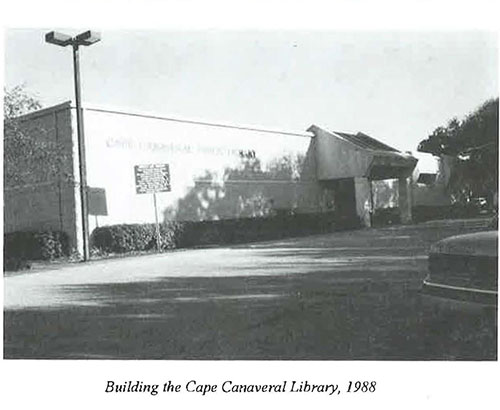
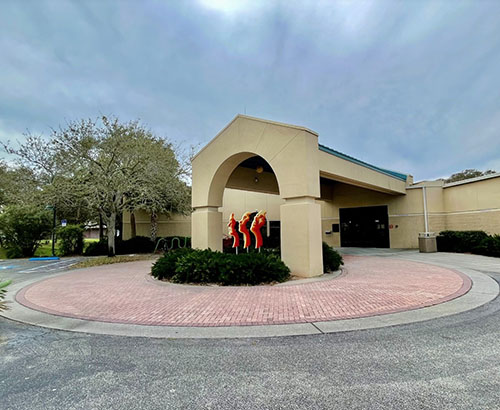
Catherine Schweinsberg Rood Central Library
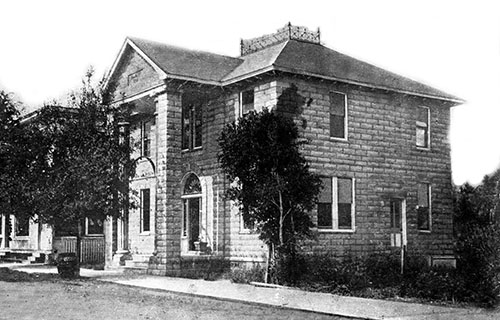
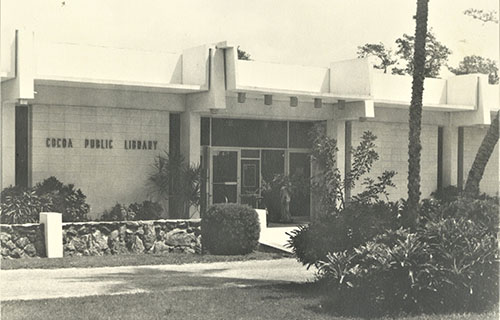
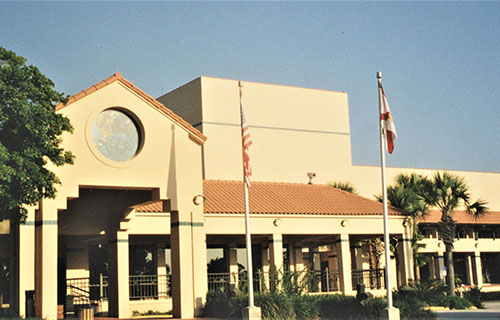
The Central Brevard Library’s history as a public library in Cocoa dates to 1895.
A group calling itself AVILAH (A Village Improvement Library Art History) was formed to work toward cultural programs for the community. Eventually, the library was the recipient of the group’s efforts. A room was rented for $5 a month for a library, but there were no books nor furniture. Citizens donated books, chairs, and tables and until 1942 they paid $1 a year to use this little library. The ladies of the community took turns acting as librarian in charge.
At the end of five years, the library had to move when the building was sold. Various moves ensued and library supporters even moved an existing building to a new lot although the bottom of the building gave way with all the books landing on the road. This put a new drive and zeal into the group, which announced its desire for a new building. With $500 earned from bazaars and suppers, the group started to build a building which was to cost $2,500. This building would be the second concrete building in Cocoa and would be paid for at its completion.
In 1942, between 5,000 to 6,000 books were held by the library and it was deeded to the City of Cocoa. At that time, the City maintained the library through its annual budget.
In June 1954 the City signed a contract with the County to provide free service, with the City giving one third of the funds needed and the County, two-thirds. In 1955 the first professional librarian was hired.
In 1965 a new building program was initiated. This resulted in the former Cocoa library at 430 Delannoy Avenue, a 14,000 square foot building with a capacity for 88,000 books, with all the modern library services provided. Cost of the project was $250,000 and was completed that year. That library served the citizens of Cocoa and Rockledge as well as part of the Brevard County Library System until the concept of a central library for Brevard was embraced by the County Commission in 1985.
In January 1990, a 97,000 square foot facility with more than 108,000 volumes, the former FLORIDA TODAY building, was dedicated as the Central Brevard Library and Reference Center, a long way from that first building in 1895, but still dedicated to serving the citizens of our county.
Continually expanding the services provided, the Board of County Commissioners approved renovations to the second floor in June of 1995 to give the library space for the newly designated Federal Documents Depository. When that program ended the floor became home to an expanded genealogy collection and in 2011 the archives of the Brevard County Historical Commission were also relocated there.
The newest addition to the library was the Creative Lab which opened in 2016. The Lab provides patrons with access to 3D printing services, audio and video production studios and software, and programming for all ages. The mobile library and Talking Books programs are also based out of this location.
In 2017 the library was renamed in honor of former Library Services Director Catherine Schweinsberg Rood who served the county for thirty-two years.
Cocoa Beach Public Library
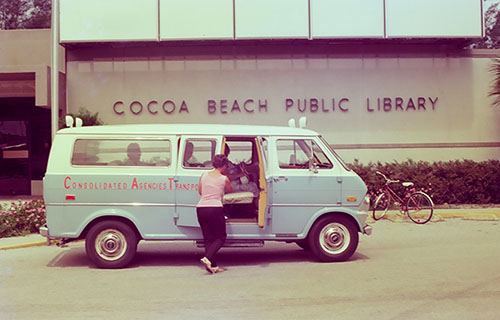
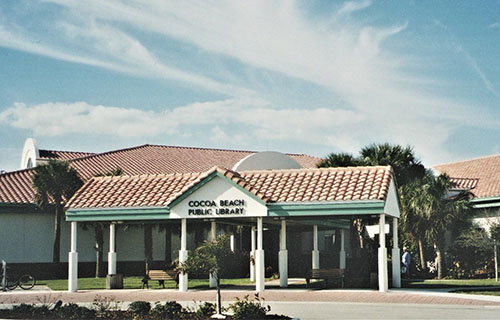
The Cocoa Beach Public Library began as a project of the first Women’s Club of Cocoa Beach, opening in December of 1954.
On May 21, 1955, the library officially opened in one room adjacent to the old City Hall. In the first six months, 110 books were circulated. Ruby Gammage was in charge of this library. On February 15, 1959, the library moved to larger quarters at 41 North Orlando Avenue. Lillian Gartner was hired as the first librarian and served the Cocoa Beach Library until 1966.
With the aid of the Cocoa Beach branch of American Association of University Women, A Friends of the Library group was organized in 1961, and the group was instrumental in passing the $60,000 bond issue for the original 5,200 square foot building which stood south of the present city hall, 55 South Brevard Avenue. The site itself was donated by Mr. and Mrs. Gus Edwards, early developers of Cocoa Beach.
In March of 1967, Cocoa Beach residents again voted in favor of a library bond issue, this time for the sum of $200,000 to nearly triple the size of the building, to 15,400 square feet. The expanded library opened to the public on March 30, 1969. Librarians during this time were Barbara Ortiz, Trudy O’Conner, Evelyn Waechter and Ruth Milliken.
In 1975 and 76 there were several contentious discussions with the city library board members and Brevard County concerning whether the library should join the Brevard County Library system. In March of 1976, a compromise was reached and an agreement signed to join the system.
Plans were made to expand this library, but under the leadership of Library Director, Ray Dickinson a decision was made to build a new library in town. In 1993 the search began for a possible site. The decision to build both a new post office and library on the site off North Brevard Avenue was made in 1994. Land was purchased for $1.1 million dollars, and the Friends of the Library worked hard to raise $225,000 towards the construction of the new building, and the state of Florida provided a $400,000 construction grant. The new 24,000 sq. ft. library was opened in September of 1998.
In 2007 an addition was constructed on the north side of the building which added 2,100 sq ft of space including meeting and study rooms and a room for computer use. This $440,000 expansion project was funded entirely by the Friends of the Library.
In August of 2015, Ray Dickinson, who served faithfully as the Cocoa Beach Library Director for thirty years, retired for a well-deserved rest.
Cocoa Beach’s newest director, Lisa Olzewski, has implemented many renovation upgrades to the library since 2015. These include vinyl flooring throughout the building, renovated bathrooms, new computer furniture, seating, air conditioning upgrades and an expanded DVD collection.
In 2016, the library received a surprise bequest from a former library patron, Ruth Schroer. Her $665,000 gift helped the library with the purchase of new library materials and computer furniture.
Eau Gallie Public Library
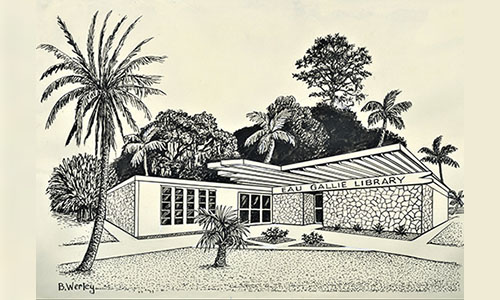
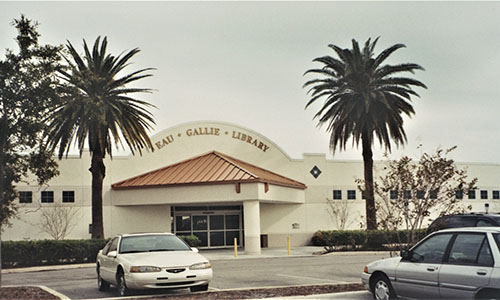
A library for the Eau Gallie Woman's Club members, an outgrowth of a Women's Christian Temperance Union group, began informally with an exchange of books and periodicals among their own group during the 1920's and 1930's. In those days, especially in sparsely-settled Brevard County, the federated women's clubs served also as the conscience of each community — forerunner of the later activities of garden clubs, PTA groups, homemakers, and leaders or social and cultural concerns.
In 1939, the Eau Gallie Woman's Club officially sponsored a circulating library, which began with 22 books and some shelves in a member's office on Ninth Street, now Eau Gallie Boulevard.
Some 125 books later, a niche was found in the corner of a public dining room, also owned by a member. Subsequently, a library was opened in the Woman's Club building on Montreal Avenue.
In 1940, a room in the old City Hall building on Highland Avenue was offered the Woman's Club Library by the city fathers. Mrs. Edith Morgan was appointed by the Woman's Club to serve as librarian, in which capacity she served as a dedicated volunteer for many years.
Woman's Club members organized bake sales, dinners, card parties and other social activities to raise funds for books and materials, and supplied volunteer workers to keep the library open some 10 hours a week.
In 1954, the Eau Gallie Woman's Club entered into an agreement with Brevard County commissioners whereby they made the Woman's Club Library a free public library and expanded library service. A year later, when enlarged quarters were offered the Woman's Club Library in the Eau Gallie Civic Center, following the opening of the new bridge and Eau Gallie Causeway, the Woman's Club executive committee met with Eau Gallie councilmen and decided to transfer their library to the city. The rapid growth of the area necessitated opening the library for longer hours, and necessary fire insurance on almost 4,000 volumes which was prohibitive for the Woman's Club.
It was mutually agreed between the Eau Gallie Woman's club and the City of Eau Gallie that a library board be appointed by the city to administer the library and that the library be called “The Eau Gallie Municipal Library". By ordinance enacted July 25, 1955, the City of Eau Gallie set up a free municipal library and the Woman s Club Library by such name ceased to exist.
In October of 1962 all the years of hard work paid off when a new midcentury modern 3,500 square foot library building, designed by architect Rhoderic F. Taylor was dedicated. It opened with 15,000 volumes to take care of the needs of 4,000 patrons, who had been re-registered the previous December.
Since it opened in 1962 the library has been expanded twice. First in 1967 when an additional 3200 square feet was added, and again in 1974 for a total of 10,600 square feet of library space. The Eau Gallie Public Library is a testament to the faith of the founders of the Eau Gallie Woman's Club.
Franklin T. DeGroodt Memorial Library
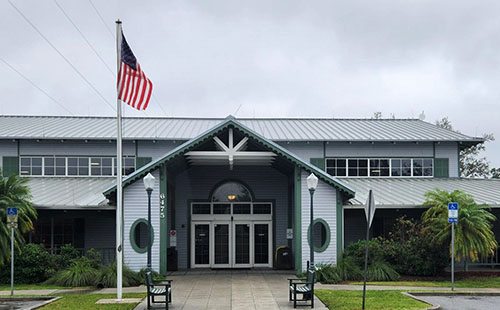
The history of the Franklin T. DeGroodt Memorial Library is intertwined with that of the Palm Bay Public Library. During his tenure as Director of Special Projects at the General Development Corporation, and Mayor of Palm Bay in the 1970s, Franklin DeGroodt was instrumental in the creation and funding of the Palm Bay Library, as well as advocating for its expansion and entrance into the Brevard County Library System.
When the town agreed to build an all new library in 1991, with the intention of closing the Palm Bay location, there was immediate community pushback. Instead, the City Council, with agreement from the Brevard County Board of Commissioners agreed to keep the Palm Bay Public library open and to build a new library.
As the entire collection was being moved to the new DeGroodt Library location, fundraising efforts began again, headed by the Friends, to keep the Palm Bay Library operating with book and facility funding.
The DeGroodt Library opened its doors to the public in June 1992.
Dr. Martin Luther King, Jr. Public Library
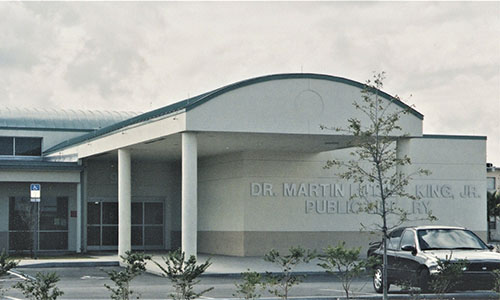
In 1972 a group of concerned South Melbourne residents approached members of the Melbourne Library Board about their desire to see a library branch built in a predominantly African American neighborhood in South Melbourne. A joint effort ensued that involved the Library Board, the Brevard County School Board and the city of Melbourne. It was decided that a school library already planned for the new Stone Middle School on University Blvd. would be expanded and made available for community use. The idea of combining a school and community library to save money and staffing had been used once before at Meadowlane (later W. Melbourne), and had proven to be successful. The city agreed to pay the extra $52,000 for an additional 2,600 sq. feet of space and to provide the initial $20,000 worth of books. Adults were able to use the adult library at any time and have access after school hours. The library opened in 1973 at the school which was named for John Sone who was an early pioneer, business owner and Brevard County’s first black superintendent of public schools.
The Friends of the Stone Community Library along with other concerned citizens requested admittance to the Brevard County Library System which was approved in October 1980. A joint use agreement was signed by the Chairman of the Brevard County School Board, the City of Melbourne and the Brevard County Board of County Commissioners. This use agreement provided for the school library facility to be opened to the community for library programming, library collection development and as a focal point for community organizations and activities.
In 1999 a new free standing 10,000 sq. foot costing $1 million was built across the street from Stone Middle School, with Library Director Estella Edwards. Community leaders and the Friends of the Library voted to name the library in honor of Dr. Martin Luther King Jr.
Melbourne Public Library
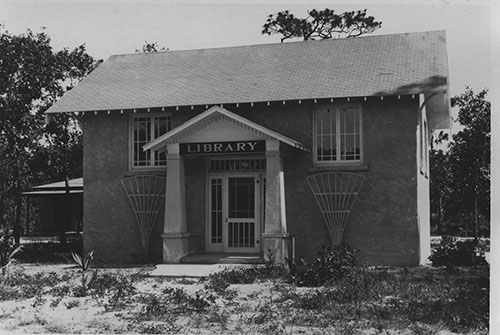
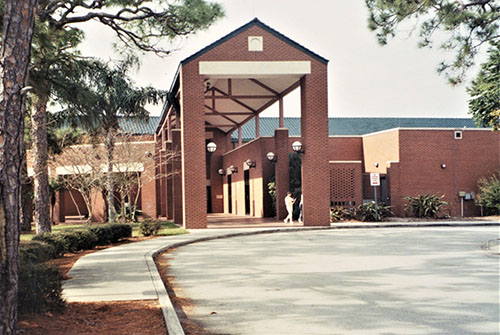
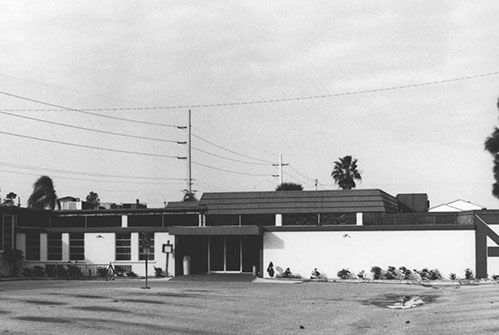
Melbourne Public Library was founded in 1918 by a group of volunteers calling themselves the Library Association of Melbourne. The group, headed by Mrs. Stanford Wells, operated the library until 1954, when it became city owned.
In 1922 a Library Association was formed with the idea to build a permanent structure to house the more than 1,500 books. Fundraisers were held and a piece of property on Strawbridge Avenue was purchased for $600. The location was just east of what is today Trinity Towers East.
By May 1924 a library building was erected that cost $2,500. Membership in the Library Association cost $1 per year, or one could rent books for 1 cent a day. Library operations were funded by membership fees and contributions from the City and from local organizations.
In 1954 a new building was provided for the Library by the Civic Improvement Board on land which had been donated to the city of Melbourne by the pioneer Wells family. The air conditioned and heated mid-century modern building was designed by the architect Rhoderic F. Taylor, who was also the architect for the Eau Gallie library, and cost just under $30,000. The Library was then operated under a series of agreements between the City and the County under which all county residents were served. In 1956 a support group, the Friends of the Melbourne Library, was formed. It has since lived up to its name by providing strong advocacy for the Library. After several additions over the years and continuing growth of demand and deterioration of the library facility, the need for a new building again became evident.
In 1986 the library moved to a temporary rental facility while a new 25,000 square foot building was planned and constructed. The new library opened to the public in August of 1989 at a cost of over $1 million.
Melbourne Beach Public Library
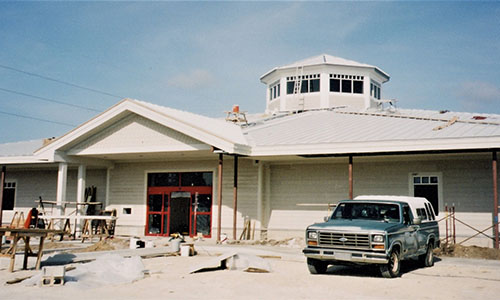
When the residents of Melbourne Beach discovered that a lot on the corner of Ocean Avenue was being developed into a convenience store, they were successfully able to halt the process. When the city held a special election in June of 1999, 73% of voters were in favor of a bond referendum to purchase the land for the use of a new public library, paying about $30 a year more in property taxes to help fund a $2.5 million library. Brevard county paid for the library’s construction, estimated at $1.5 million, and agreed to provide $200,000 a year toward operating cost. After three years of community fundraising for books, computers, furniture, art, and supplies by the Friends of the Melbourne Beach Public Library, the Melbourne Beach Public Library celebrated its grand opening on October 5th, 2002.
The building was designed in a Florida Vernacular architecture with a metal roof, lap siding and a wide porch to fit in with some of the nearby historic buildings. The original library director, Frank Harris, was Involved in its design. Other unique features were self-check out for patrons and lockers in the lobby where patrons could pick up their books even if the library was closed.
In the two decades since the library’s opening, it has served as a community hub, a beacon of knowledge and a place in which to learn and be inspired. Since its inception, the library has benefited from vibrant community support in the form of various imaginative events such as our 2003 Vintage Gala, the 2006 Friends of the Melbourne Beach Library Golf Tournament and our Coconut 5k. In regards to programming, the library has also pioneered the Brevard County Library System’s first Read to a Dog program.
Merritt Island Public Library
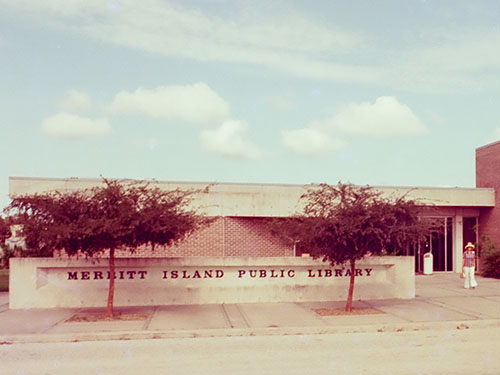
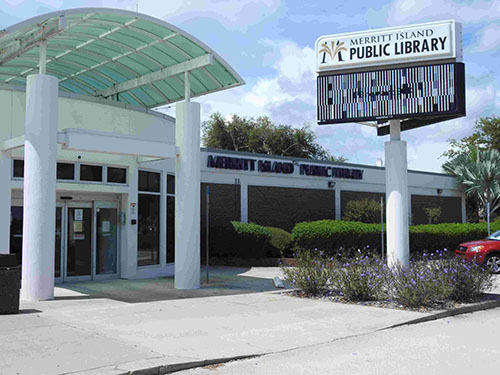
The Merritt Island Library was begun in 1965 by a group of concerned residents. They formed a Friends of the Library group to build interest of the residents of Merritt Island in supporting the creation and eventual building of a library. The first library was in a trailer in the parking lot of the bank located on the Southeastern corner of the intersection of State Road 520 and Courtenay Parkway, and the books were donated through a community book drive. In order to raise money to operate a library, a referendum was held and the citizens of Merritt Island agreed to tax themselves up to .5 mills for a library. The legislature then established the Merritt Island Library District. The first district board was appointed December 30, 1965 by Governor Hayden Burns, and Leonard Spielvogel elected by the board to be its first chairman. The board of the Merritt Island Public Library consists of fifteen members that are appointed by the governor.
On March 26, 1966 the Merritt Island Library moved to the Civil Defense Building at the corner of Courtenay and Myrtice. In 1969, with a federal grant of $200,000 the present building was built to a size of 17,500 square feet with the ability to expand in the future by adding a larger second story. In 1996, the Board undertook a major building expansion, but instead of building a second floor, they chose to enlarge the size of the first floor. In 1999, the board built a conference room on to the front of the library, and the following year constructed a canopy over the entryway. In 2009 the library was enlarged again, adding reading rooms and a computer lab, bringing the square footage up to 25,200.
In 1972 the library was incorporated into the County Library System. The first contract was signed in 1976. It provided for the County to take over salaries of the personnel, to pay the utilities and maintain the air conditioning and other parts of the inside of the building. The tax district would still own and maintain the building and grounds. A new contract was signed in 1989, and amended in 1998.
Mims/Scottsmoor Public Library
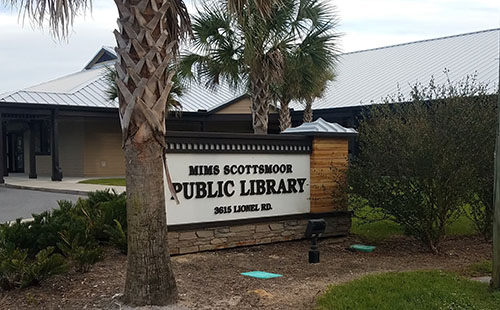
June Horner, a longtime resident of the North Brevard area, first initiated efforts to establish a public library in the Mims/Scottsmoor area. In November 1993, Mrs. Horner, together with Joann Katrick, and Frank Buckowski, appeared before the Brevard County Board of Commissioners with a petition of 1700 signatures to pass along to the County Library Board.
In January 1994, Mrs. Horner, Mrs. Katrick, and Mr. Buckowski appeared before the County Library Board. They were informed that there were no funds to establish a library in the Mims/Scottsmoor area, however; the Board said they would accept the petitions, and that they could proceed with their plans to have a community library. The committee of three continued its efforts by having monthly meetings and fundraisers and organized the The Friends of the Community Library Center of Mims/Scottsmoor.
Finding land and a building for the library was also a challenge. JoAnn Katrick came up with the idea of approaching the School Board. A joint use agreement was negotiated. On October 23, 1997, a resolution was adopted creating the Mims/Scottsmoor Public Library Advisory Board. After several delays, a building made up of 24 portables formally used on Park Avenue in Titusville to house the Brevard-Seminole State Attorney’s Office was moved at cost of $105,000. The library was housed in 9100 square feet and the Community Education Center is housed in 5100 square feet on the grounds of Pinewood Elementary School.
The Mims/Scottsmoor Library opened for business on December 15, 1998, Jessica Seiler was the library's first director. By 2001, the library staff increased to eight persons and included four full time and four part time employees.
After some deterioration of the original building, it was decided to demolish the original and replace it with a new building. The last day the old building was open to the public was December 29, 2017, and the Grand Reopening in the new building was on Saturday, July 28, 2018.
Palm Bay Public Library
In 1970 the General Development Corporation, a large land development company responsible for the creation and planning of several Florida communities, foresaw the need for library facilities in the city of Palm Bay. The Director of Special Projects, Franklin T. DeGroodt, was assigned the task of developing a library in a space provided by General Development Corporation’s Yacht Club on Turkey Creek. The library contained 2000 volumes and served near 200 patrons on Wednesday afternoons and Saturday mornings. After the Brevard County Library Bookmobile began to Palm Bay regularly visit Palm Bay, the Yacht Club Library was closed and the books placed in storage housed in the old City Hall on Main Street.
During the intervening years, Franklin T. DeGroodt's interest in a library never waned. During his stint as Mayor of Palm Bay, he began a study of the matter in 1978 with the Mayor’s Citizen's Assistance Committee, and began to push for the establishment of a permanent library in Palm Bay. After years of planning, in 1980 the Palm Bay Public Library opened to the public as triple wide modular unit, and over the next two years, attempts to finance further expansion of the library or building a new, larger building failed.
By 1982 the Palm Bay City Council considered adding two more modular units to the library budgeted for $43,600 using a utility tax, in an attempt to meet square footage requirements for inclusion into the County Library System. At this date the Palm Bay Library only met 11 of the 20 prerequisites for admission into the County System. In 1983 the Board of County Commissioners voted unanimously to accept the Palm Bay Library into the County Library System.
Revitalized, in 1983, the Friend of the Palm Bay Library group began a grassroots library building drive to build a new 8500 sq. foot home for the Palm Bay Public Library, opening in 1984.
In 1990 it was announced that a new library, the Franklin T. DeGroodt Memorial Library, was to be built in Palm Bay. A state-of-the-art 23,000 sq. foot library intended to replace the current Palm Bay Public Library. The current building was to be used by the City of Palm Bay as an administrative building for five years at the end of which the County would revisit the building's purpose. This was immediately met with pushback from the community to keep the original library open. As a result, the City Council, with agreement from the Brevard County Board of Commissioners, agreed to keep the Palm Bay Public Library open while still building the new library.
Port St. John Public Library
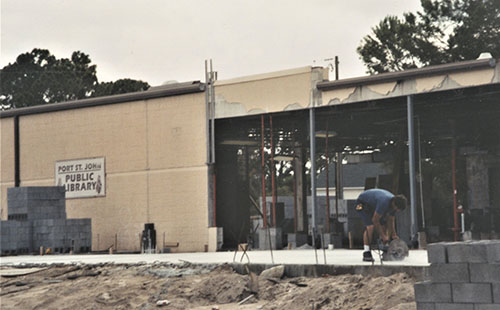
The Port St. John Public library was created after the Brevard County Board of County Commissioners determined that an additional public library was needed to serve the residents. The 9,000 square foot library was on October 8, 1988.
Community support was apparent from the beginning when volunteers offered to assist the staff, to help with the library dedication, and to promote the organization of a Friends of the Port St. John Library group. The first organizational meeting of the Friends of the Port St. John Library was held in November 1988.
In 2002, ground was broken for a remodel and expansion of the Port St. John Library. The population had increased, and a bigger facility was needed to meet the needs of the community. The library reopened just under a year later in January 2003. The renovations expanded the library from 9,000 to more than 15,000 square feet. A grand opening celebration was held on March 1, 2003.
Thanks to the efforts of the Friends of the Port St. John Library, funds were raised and a playground and gazebo were dedicated in 2008.
Satellite Beach Public Library
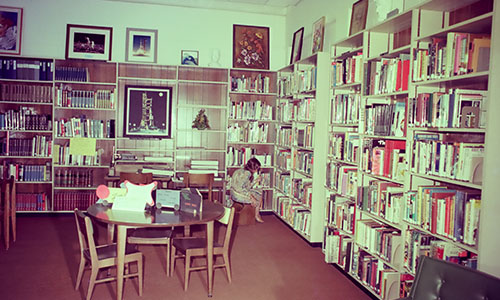
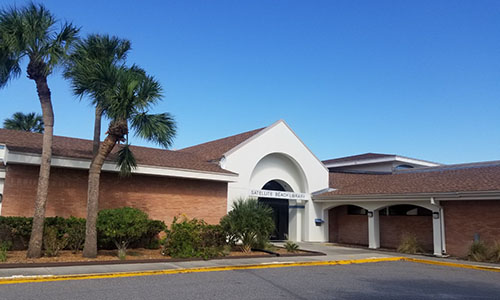
In 1965, members of the Satellite Beach Woman’s Club and the Satellite Beach Lion’s Club saw the need for a public library in Satellite Beach. They approached Mayor Percy Hedgecock and the Satellite Beach City Council expressing the need. All agreed a library should be built in this community.
Investigating committees for construction, finance and library operations were formed. A community book drive was held; books were collected and housed at the Southeast Bank Building. The City of Satellite Beach selected a site on Cassia Boulevard. Two buildings were constructed – one for a library and the other for a civic center complex The Board of County Commissioners accepted the library concept and provided two-thirds of the operating expenses. The City of Satellite Beach contributed the other third. A head librarian was hired to operate the facility with a volunteer staff.
In April 1966 the Satellite Beach Public Library opened for business. Within two years the library outgrew its one room and occupied the remainder of the 6,500 square foot building.
In 1972, by virtue of a tax referendum, provision was made for the establishment of a County Library System. The first contracts were signed between the municipalities and the County in 1976. Responsibility for facility maintenance was shared. In 1985 a contract was signed giving Brevard County and the Brevard County Library System full responsibility and financial authority over library staff and facilities.
Increased usage and crowding of the facility made it apparent that a new facility was required to meet the demands of the community. In 1988, the Brevard Board of County Commissioners approved a new location for the Satellite Beach Public Library, located on the former Indian Harbour Beach wastewater treatment site. Five of the approximate 39 acres were dedicated for the building of the library.
In 1991, a new 19,000 square foot facility opened for the public, nestled between Satellite Beach and Indian Harbour Beach.
South Mainland Public Library
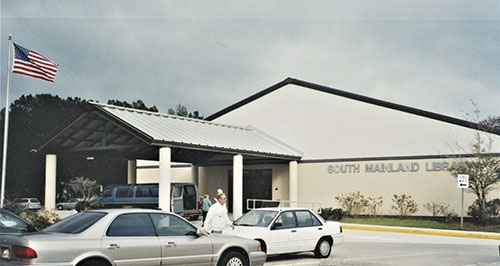
Library service began for the area in 1975 with a bookmobile coming to Micco for 2 hours per week. In 1984, a Friends of the Library group formed in response to the bookmobile having scheduled hours and locations cut from service. Their goal was to establish a permanent library for the furthest area south in the County. In 1985, plans were presented to the Brevard County Library Board and the acquisition of land was encouraged and the group continued to fundraise. After a study was completed by an outside consulting firm on behalf of Brevard County Libraries, it confirmed the necessity for building a new library for the southernmost area. Resident Ron Abbot freely gave land to construct a new library, and then in 1986, the County Commissioners approved funding for a South Brevard Library and approved Micco as the site of the first county-built library.
The ground-breaking ceremony took place in March, 1987 with the grand opening following soon after in November. Additional expansion took place in 1998 to meet the needs of the growing community. Improvements have continued over the years with a beautiful fully furnished reading room, new enclosed study rooms, and interior remodeling to give the space an opening and inviting feel befitting the friendliness of its community, staff, and patrons.
Suntree/Viera Public Library
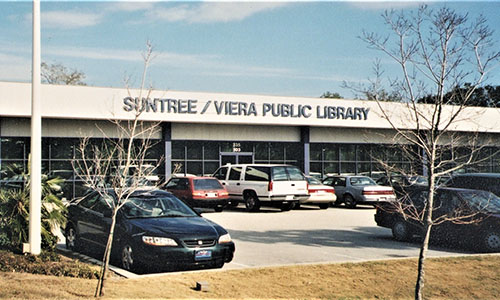
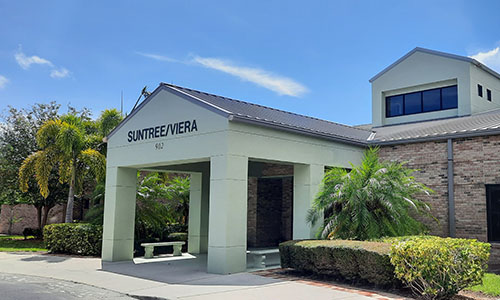
The Suntree/Viera Library opened in November 1997 in a rented facility of 7,500 square feet. At that time the library had about 10,000 items available for check out. Within the 2 weeks in November that the library was open, over 2,000 items were checked out. The Library’s circulation has never slowed down. In August 2001, the month before construction began on the new Suntree/Viera Library building, over 22,000 items were checked out.
In December 1997 the Brevard County Board of County Commissioners accepted a donation of 14.56 acres of land donated by Harriet Golding for a freestanding library building. In May 1998 the library expanded by 1,500 square feet when the Friends of the Library rented an additional area to be used as a meeting room.
Plans began for the new library building on the donated land, and the new Suntree/Viera Library opened to the public in 2002.
Titusville Public Library
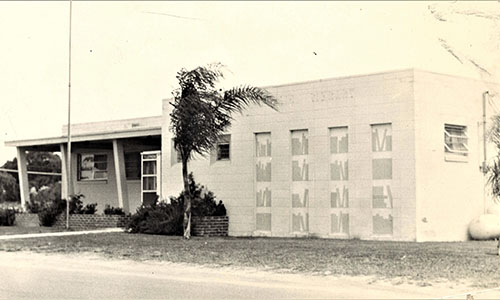
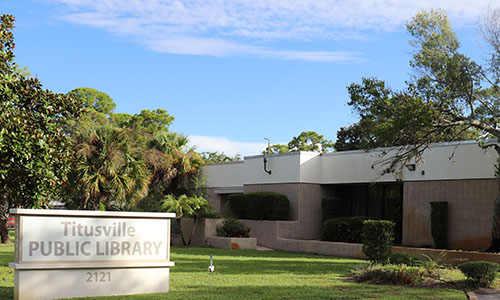
The Titusville Public Library can trace its beginnings to June 1900 when the first library was formed in Titusville by the Woman’s Club of Titusville, formerly the Progressive Culture Club. By 1902 they held 200 volumes. In August 1922, a building at the corner of Washington and Palmetto Streets was bought for $4500. It became the new Club building and the library was located on the 2nd floor and it was open two afternoons a week.
By 1948 the two-story building was sold, and the library had grown to 2,500 volumes. It moved into temporary headquarters above the Fire Department. In 1954, the Woman’s Club acquired a building which had been formerly used during World War I as a canning plant. The library became an official public library for North Brevard that same year.
In 1962, a new library designed by Frans Larson was constructed. It was twice the size of the former one. In 1966, the library was renamed the Mildred Bruner Memorial Library in her honor of the Women’s Club member who worked in the library and served as the chairperson for the library board.
In 1963, the Indian River City Library was made a branch of the Mildred Bruner Memorial Library. The Indian River City Library was first established in 1957, and the library’s first home was in a corner of the Indian River City Post Office. In 1958 the new library building was opened. It was located on the corner of Coquina and Magnolia Avenues.
A referendum to finance construction of a new library facility passed in 1969. The building was completed in 1972, with both the Indian River City Library and Mildred Bruner Memorial Library closing their doors and combining their collections to become the North Brevard Public Library. In 1979 a 4,380 square foot addition was completed, and it provided meeting room space and more shelving area. Another expansion was completed in 1996 and interior renovations including a new conference room were completed in 2018.
In 2004, the Board of County commissioners approved the name change from North Brevard Public Library to Titusville Public Library.
In 2008, the genealogy room was renamed “The Nancy C. Sieck Memorial Genealogy Area”.Nancy volunteered 25 years of service to the Titusville Public Library and the Genealogical Society of North Brevard. There are over 2200 genealogy books as well as periodicals, microfilm and microfiche available for research in the genealogy room.
West Melbourne Public Library
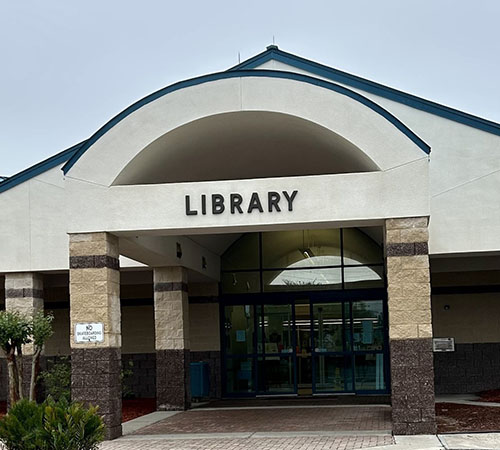
The Meadowlane Community Library, now the West Melbourne Public Library, was developed by residents of West Melbourne, Melbourne Village, and nearby unincorporated areas of Brevard County. First proposed in 1968, the library opened its doors on October 1, 1970.
Meadowlane Community Library was the first combined school and public library in Brevard County. Both libraries were under the direction of one librarian, its collection included 2,000 adult and 12,000 children’s books denoted by the community.
In 1976, the school and public libraries became separate entities, but were still housed in the same facility. Operation of the school library became the responsibility of the Brevard County School Board. The public library was operated by the Brevard County Library System.
In March 1991, the library vacated the Meadowlane Elementary School and moved to a rental facility in the Metro West Shopping Center at the comer of Wickham Road and New Haven Avenue in West Melbourne. By 1994, the circulation and book collection had increased to keep up with population growth and patron demand, and a search for a suitable building site and funding for a new library was begun.
In January 1999, a new freestanding modern and comfortable library, renamed the West Melbourne Public Library, celebrated its grand opening on the comer of Minton Road Wingate Boulevard.







